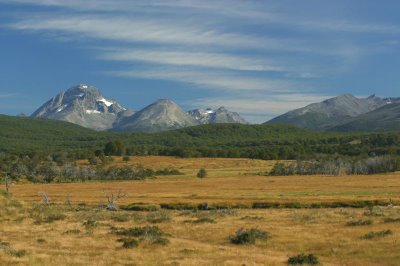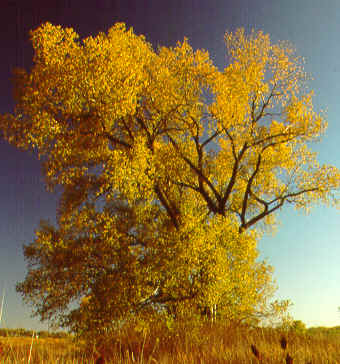 The endangered lesser long-nosed bat (Leptonycteris curasoae) is one of a few bat species that undergoes long distance migrations. To survive these migrations, the bats must time their travel to coincide with the flowering or fruiting activity of their food plants. The floral resources they depend upon have been threatened by wildland habitat conversion and fragmentation. Rural residents have also mistaken these large-bodied bats for vampire bats and their caves have been targeted for destruction. In order to implement effective conservation strategies, it is crucial that we understand bat habitat requirements and migratory corridor locations. Image Credit: Merlin D. Tuttle, Bat Conservation International
The endangered lesser long-nosed bat (Leptonycteris curasoae) is one of a few bat species that undergoes long distance migrations. To survive these migrations, the bats must time their travel to coincide with the flowering or fruiting activity of their food plants. The floral resources they depend upon have been threatened by wildland habitat conversion and fragmentation. Rural residents have also mistaken these large-bodied bats for vampire bats and their caves have been targeted for destruction. In order to implement effective conservation strategies, it is crucial that we understand bat habitat requirements and migratory corridor locations. Image Credit: Merlin D. Tuttle, Bat Conservation International“Bats” About Border Security Fences
Where are the People for the Ethical Treatment of Animals when we “need” them? – busy wearing chicken suits outside of fast food restaurants or buying stock so that they can attend company stockholder meetings to make their point, I guess.
If PeTA were truly interested in the plight of animals, they would direct their efforts to have our Government put up a fence along our southern border. This fence would protect valuable habitat that many animals (and plants) need to live and survive.
Excerpts from The Washington Times –
Long-nosed bats evict a covey of aliens
By Stephen Dinan - THE WASHINGTON TIMES - September 14, 2006
CABEZA PRIETA N.W.R., Ariz. -- Three years ago, the endangered lesser long-nosed bat had been ousted from a cave here, one of just four known maternity roosts in the United States, by illegal aliens who used the cave as a cool rest stop on their route north.
Now, the aliens are out of the cave, the bat is back -- and all it took was a fence.
Even as the U.S. Border Patrol and now the National Guard fight to keep people from crossing illegally into the United States, a secondary battle is being waged to keep some of the nation's most pristine lands and endangered species from becoming collateral damage.
"All the actions we try and do, a lot of it gets minimized or marginalized by the traffic we have to deal with," said Curt McCasland, assistant manager and biologist at Cabeza Prieta, a national wildlife refuge the size of Rhode Island that contains 56 miles of the U.S.-Mexico border.
Years of border-control efforts to the east and west have funneled illegal aliens straight into southern Arizona and across its three wildlife refuges, national forest and park land, an Air Force bombing range and the Tohono O'odham Indian Reservation.
It's a fragile ecosystem where car tracks or even walking trails can remain for decades after they are last used. And aliens leave behind abandoned vehicles and millions of pounds of garbage -- estimates run between 5 and 8 pounds per illegal crosser.
"Some areas are so polluted by trash and human waste that the cleanup has to be contracted to professional companies with employees outfitted with haz-mat suits," said Roger DiRosa, Cabeza Prieta's manager.
----
But those who take care of the federal lands are fighting back with increased attention and new techniques -- even if they sometimes worry about the choices they have to make, such as the bat-cave fence.
Illegal aliens started using the cave in 2002, chasing the 4,000 to 6,000 bats that use it away that year, and again in 2003. Mr. McCasland said they thought briefly about trying a gate in front of the cave, but research suggested the bats might still avoid the cave. and the refuge decided it couldn't afford to take a chance and lose the bats for a third year.
Some see the success of fencing in Cabeza Prieta as an obvious solution -- both to the environmental issue and the whole border.
 Female lesser long-nosed bats undergo a single pregnancy each year (Ceballos et al. 1997, Fleming and Nassar 2002). In the group of northward migrating bats, mating takes place between October and December in south-central Mexico. After migrating north and a gestation period of about 6 months, females give birth to a single pup in northern maternity roosts (hot caves), most of which are located in the Sonoran Desert. After the young are weaned, maternity roosts disband and adults and young bats migrate south in late summer and early fall. Image Credit: Yar Petryaryn
Female lesser long-nosed bats undergo a single pregnancy each year (Ceballos et al. 1997, Fleming and Nassar 2002). In the group of northward migrating bats, mating takes place between October and December in south-central Mexico. After migrating north and a gestation period of about 6 months, females give birth to a single pup in northern maternity roosts (hot caves), most of which are located in the Sonoran Desert. After the young are weaned, maternity roosts disband and adults and young bats migrate south in late summer and early fall. Image Credit: Yar Petryaryn
"Fencing the cave brought the bats back. Fencing the border would be cheaper than the cleanup and would bring the environmental quality back," said Rep. Steve King, Iowa Republican, who has visited the cave. "A border fence could help lessen the environmental, economic, drug and crime impacts on American society by directing all traffic through the legal ports of entry."
----
The House will vote today on a bill to build a double-walled fence along 700 miles of the border.
The bat-cave fence, which is much simpler, tops out at 10 feet tall, and has sharp points that jut outward at the tips to deter climbers. It was completed in 2004, and the bats have returned each year since.
In that time, Mr. McCasland said he has detected just one breach, and said it was because of a flaw in the design, which they will correct.
He said their fence is proof that fencing can work in some places, but he said it's still not the right solution for more remote locations, where the Border Patrol simply doesn't have the staff to man it.
"If you're not patrolling it and you can't respond to it quickly, it's not going to give you the result you need," he said. "Even if it takes them 15 minutes to get over the first fence, and 15 minutes to get over the second fence, there's no one coming" to capture them.
He said a better strategy is ground-based radar, cameras and sensors to track movement, and having enough Border Patrol agents to respond.
For the federal lands, the border conflict is absorbing time and money.
Between a third and half of Cabeza Prieta's annual budget goes to personnel, equipment and repair costs associated with illegal immigration.
----
Buenos Aires includes about five miles of the U.S.-Mexico border, and the main problem there is foot traffic -- some 200,000 to 300,000 illegal aliens that walk through the refuge each year -- while the major problem at the more remote Cabeza Prieta is vehicles cutting trails and being abandoned.
That was the case at Organ Pipe Cactus, until officials recently finished a vehicle barrier. That has cut vehicle traffic by 95 percent.
 Dense stands of organ pipe cactus in Coastal Thornscrub are important feeding areas for nectar-feeding bats on their northward migration. Image Credit: Arizona-Sonora Desert Museum
Dense stands of organ pipe cactus in Coastal Thornscrub are important feeding areas for nectar-feeding bats on their northward migration. Image Credit: Arizona-Sonora Desert Museum
As bad as the aliens are, the Border Patrol also sometimes tears up the land in pursuit of illegal crossers, which has drawn the ire of some environmental groups. But officials here say they understand the job the Border Patrol agents are doing and are thankful for them.
At Cabeza Prieta, the bat cave isn't the only fight. The endangered Sonoran pronghorn, a deerlike creature that has the distinction of being the fastest land animal in North America, is caught in the middle of both a drought and the wave of illegal immigration.
In 2001, the population dropped from about 150 animals down to 19.
To meet their mission of protection, the managers have sometimes had to make difficult decisions that seem to aid the illegal aliens.
One example is the 250-gallon water tanks they have placed in the refuge as a way to keep the illegal aliens from smashing irrigation water pipes meant to help grow the plants to feed the pronghorn.
"I wasn't real thrilled about it, but we had no other option," Mr. McCasland said. "It was either that or let them break it."
Read All>> (free subscription)
Of course we know what PeTA’s real agenda actually is … it’s veganism.
We should be happy that the Organ Pipe Cactus isn’t on the menu or Long-Nosed Bats wouldn't have anything to eat or pollinate.
UPDATE:
House Votes to Erect Fence Along U.S.-Mexico Border
FOX NEWS - Thursday, September 14, 2006
WASHINGTON — The House voted for the second time in a year to erect a fence along a third of the U.S.-Mexican border, part of a Republican effort to keep illegal immigration an issue before voters.
A new 700 miles of double-layered fencing won approval on a 283-138 vote, a bigger margin than last December when the House passed it as part of a broader bill that also would have made being an illegal immigrant a felony. The nearly 2,000-mile border now has about 75 miles of fencing.
Click here to see how your representative voted.
Rep. Peter King, R-N.Y., said the separate fence bill was needed to show Americans "we can take meaningful action to secure the border."
The House's bill last December and one passed by the Senate last May are so far apart on issues that Republican leaders haven't even tried to negotiate a compromise.
The main difference is that the Senate bill would provide legal status to millions of illegal immigrants already in the U.S., a concept supported by President Bush but opposed by most House Republicans. The Senate bill calls for 370 miles of fencing along the Mexican border.
Supporters of the new House bill said the new fencing would let Border Patrol agents focus more on apprehending illegal immigrants crossing from Mexico rather than having to man the entire border.
"We have to come to grips with the fact that our Border Patrol agents need a border fence on our southern border ... where we're now facing infiltration by members of terrorist organizations like Hezbollah," said Rep. Ed Royce, R-Calif.
The bill passed Thursday doesn't pay for the fence. Republicans, estimating the cost at more than $2 billion, said that will be covered in a later spending bill. Democrats estimated the fence would cost $7 billion, based on information from the Department of Homeland Security on costs per mile of a double-layer fence.
"This is nothing more than political gamesmanship in the run-up to the midterm elections. Sounds good. Does nothing," said Rep. Alcee Hastings, D-Fla.
Democrats accused Republicans of playing upon voters' fears to score political points. Rep. Lloyd Doggett, D-Texas, said Republicans were trying to confuse Americans into thinking "Osama Bin Laden is heading north in a sombrero."
The bill also directs the Homeland Security Department to take control of the border in 18 months and gives border agents new authority to stop fleeing vehicles. And it calls for a study of the need for a fence on the U.S.-Canadian border.
Meanwhile, the House Administration Committee approved a bill to make states to ask for photo identification from voters by November 2008 and proof of citizenship by 2010.
The full House could vote on it as early as next week.

 President Bush speaks in Scottsdale, Ariz., Wednesday, Oct. 4, 2006 where he signed the Department of Homeland Security Appropriations Act. From left are, Arizona Gov. Janet Napolitano, the president, Rep. J.D. Hayworth, R-Ariz., Rep. Rick Renzi, R-Ariz., and Rep. Trent Franks, R-Ariz. Image Credit: AP Photo/Pablo Martinez Monsivais
President Bush speaks in Scottsdale, Ariz., Wednesday, Oct. 4, 2006 where he signed the Department of Homeland Security Appropriations Act. From left are, Arizona Gov. Janet Napolitano, the president, Rep. J.D. Hayworth, R-Ariz., Rep. Rick Renzi, R-Ariz., and Rep. Trent Franks, R-Ariz. Image Credit: AP Photo/Pablo Martinez Monsivais Mexican nationals peer through the fence along the U.S.-Mexico border at Border Field State Park in San Ysidro, Calif., on Aug. 24. Image Credit: Sandy Huffaker / Getty Images file
Mexican nationals peer through the fence along the U.S.-Mexico border at Border Field State Park in San Ysidro, Calif., on Aug. 24. Image Credit: Sandy Huffaker / Getty Images file Members of the 116th Construction Equipment Support Company of the Utah National Guard extend a wall, 06 June 2006 along the US border with Mexico, a few miles from the border crossing point at San Luis, Arizona. The US Senate approved late 29 September 2006 a bill that calls for building a fence along the US-Mexican border to stem the flow of illegal immigrants. Image Credit: ROBYN BECK / AFP/Getty Images
Members of the 116th Construction Equipment Support Company of the Utah National Guard extend a wall, 06 June 2006 along the US border with Mexico, a few miles from the border crossing point at San Luis, Arizona. The US Senate approved late 29 September 2006 a bill that calls for building a fence along the US-Mexican border to stem the flow of illegal immigrants. Image Credit: ROBYN BECK / AFP/Getty Images




























